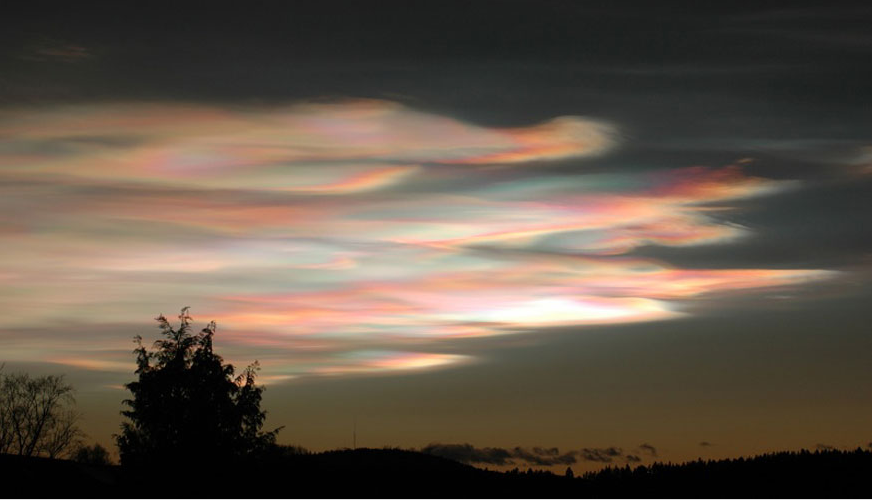Nacreous Clouds Norway 31st January 2005
Nacreous Clouds: A Stunning Phenomenon in the Norwegian Sky
On the evening of January 31st, 2005, the sky over Southern Norway was ablaze with an extraordinary sight - nacreous clouds. These captivating cloud formations, also known as polar stratospheric clouds (PSCs), painted a breathtaking display just twenty minutes after sunset. The vibrant colors and ethereal appearance of these clouds left onlookers in awe of nature's artistic prowess.
Nacreous clouds are a rare atmospheric phenomenon that occurs in the polar regions during winter. These clouds are formed in the stratosphere, the second layer of Earth's atmosphere, at altitudes of around 15 to 25 kilometers (9 to 16 miles) above the surface. Unlike typical clouds that form in the lower troposphere, nacreous clouds develop much higher up in the atmosphere.
The unique beauty of nacreous clouds can be attributed to their composition and the specific conditions required for their formation. These clouds are made up of tiny ice crystals, which scatter sunlight and create stunning optical effects. The ice crystals in nacreous clouds are typically much smaller than those found in ordinary clouds, allowing them to diffract light and produce vibrant iridescent colors.
The appearance of nacreous clouds is strongly influenced by atmospheric conditions. These clouds require extremely low temperatures, usually below -78 degrees Celsius (-108 degrees Fahrenheit), to form. In addition to cold temperatures, specific wind patterns and the presence of certain chemicals in the stratosphere contribute to the creation of nacreous clouds. These chemicals, such as nitric acid and water vapor, are crucial for the formation of ice crystals at such high altitudes.
Nacreous clouds are often observed in polar regions due to their unique climatic conditions. In these areas, the polar vortex plays a significant role in creating the ideal environment for the formation of these clouds. The polar vortex is a large-scale circulation pattern that forms during winter, trapping extremely cold air within the polar regions. This frigid air, combined with the presence of the necessary chemicals, provides the perfect setting for nacreous clouds to appear.
The colors displayed by nacreous clouds are a result of the diffraction of sunlight by the ice crystals. The diffraction process splits the sunlight into its constituent colors, similar to how a prism creates a rainbow. As a result, nacreous clouds often exhibit vibrant hues of pink, purple, blue, and green. The intensity and variety of colors depend on the size and shape of the ice crystals, as well as the angle at which sunlight interacts with them.
The sighting of nacreous clouds on January 31st, 2005, in Southern Norway was particularly remarkable. These clouds were not only visible before dawn but also persisted throughout the day and evening. This extended visibility allowed for more people to witness and appreciate the spectacle. Thanks to the skillful photography of Derick Rethans, we can marvel at the stunning imagery captured during this event.
Nacreous clouds are not only a visual treat but also serve as indicators of atmospheric conditions. The presence of these clouds can provide valuable information about the state of the stratosphere, including the presence of ozone-depleting substances. Scientists study nacreous clouds to gain insights into the dynamics of the polar stratosphere and its role in global climate patterns.
While nacreous clouds are a rare sight, they continue to captivate those fortunate enough to witness them. Their otherworldly beauty serves as a reminder of the wonders that exist within Earth's atmosphere. The events of January 31st, 2005, in Norway stand as a testament to the extraordinary and ever-surprising nature of our planet's atmospheric phenomena.

These clouds blazed in the sky over the Southern Norway twenty minutes after sunset January 31st 2005. Imaged by Derick Rethans. The clouds were visible before dawn and throughout the day and evening. Another image and video. Image ©2005 Derick Rethans, shown with permission.
Note: this article has been automatically converted from the old site and may not appear as intended. You can find the original article here.
Reference Atmospheric Optics
If you use any of the definitions, information, or data presented on Atmospheric Optics, please copy the link or reference below to properly credit us as the reference source. Thank you!
-
<a href="https://atoptics.co.uk/blog/nacreous-clouds-norway-31st-january-2005-2/">Nacreous Clouds Norway 31st January 2005</a>
-
"Nacreous Clouds Norway 31st January 2005". Atmospheric Optics. Accessed on November 26, 2024. https://atoptics.co.uk/blog/nacreous-clouds-norway-31st-january-2005-2/.
-
"Nacreous Clouds Norway 31st January 2005". Atmospheric Optics, https://atoptics.co.uk/blog/nacreous-clouds-norway-31st-january-2005-2/. Accessed 26 November, 2024
-
Nacreous Clouds Norway 31st January 2005. Atmospheric Optics. Retrieved from https://atoptics.co.uk/blog/nacreous-clouds-norway-31st-january-2005-2/.